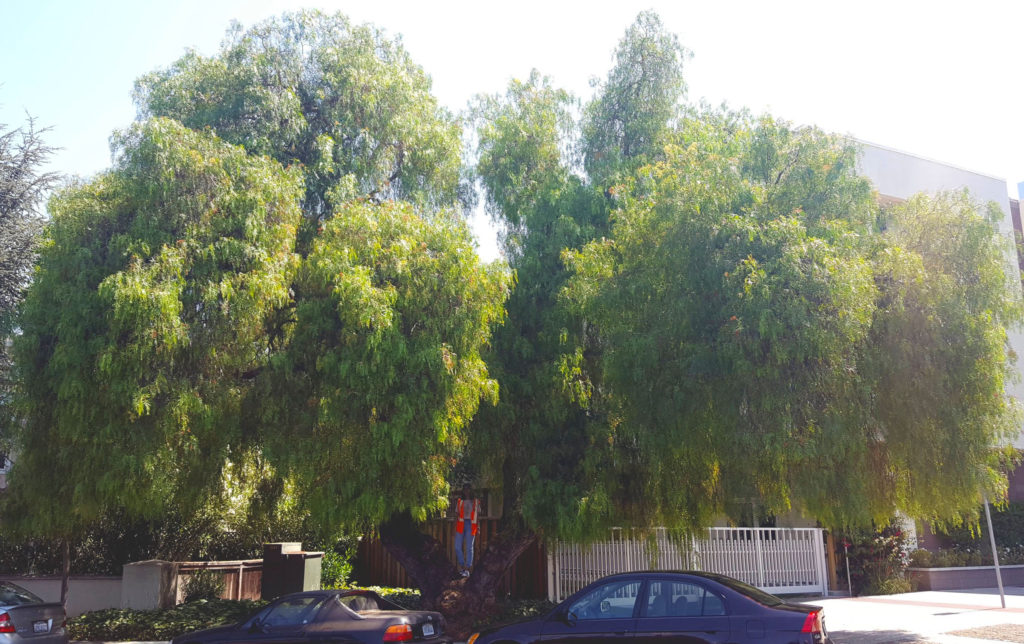- About Us
- Our Work
- Tree Info
- Get Involved
- Blog
- Volunteer
- Support Us
By Canopy Team on November 18, 2019

Photo courtesy Elise Willis
Tree Spotlight Series: Follow along as we learn about the fascinating trees that live among us. This series is in partnership with Rhee Lab in the Plant Biology Department of the Carnegie Institution for Science.
Other posts in the series: ginkgo biloba, Douglas fir, giant sequoia, Chinese tallow, silver-dollar gum, Monterey pine, green dracaena, coast live oak, cork oak, Japanese maple, silver birch, dawn redwood, Japanese persimmon ‘Hachiya’, carob, California bay, avocado, southern magnolia, flowering dogwood, red ironbark eucalyptus, blackwood acacia, narrow leaved paperbark, cockspur coral, and Chinese pistache.
The California pepper tree (Schinus molle) is a fast-growing, hardy evergreen. With an established root system, the pepper tree requires very little rainfall and is considered to be the largest of all Schinus species, growing up to five stories tall. Its wide canopy and drooping branches give it an appearance that closely resembles a willow tree, making the two species visually similar.
However, crushed leaves from the pepper tree release a distinct aroma close to that of commercial black pepper and easily sets the pepper tree apart from the willow. The leaves are narrow and cone-shaped, appearing feather-like from a distance.
Bright red and pink berries decorate the branches, hanging together in grape-like bunches. As the tree ages, its outer grey bark peels to reveal its deep-red inner wood.
The California pepper tree received its colloquial name from its high abundance, cultivation, and long history in California. However, contrary to its nickname as the “California” pepper tree, Schinus molle originates from the arid regions of northern South America and the Peruvian Andes.
It has made its way across the globe and can be found in mild to warm climates. In certain regions, it is considered to be an invasive species. In South Africa and Australia, the pepper tree has encroached onto grasslands and dry areas. It often out-grows native plant species, gradually increasing in abundance and changing the local ecosystem.
In the United States, it is found in southern to south-western states and tends to crowd out native vegetation. Interestingly, it is not officially an invasive species in California given its long-term presence, common planting, and relatively low risk in comparison to other invasive plants.
The California pepper tree bears red and pink fruits that can be used for a variety of purposes. Traditionally, these fruits were used to treat wounds and infections due to their antibacterial, analgesic, and anti-inflammatory properties.
When dried, the fruits are referred to as pink peppercorns; however, they are not actual peppercorns derived from plants of the genus Piper (e.g. commercial black pepper). Regardless, pink peppercorns have a flavor similar to that of black pepper and can be used as a spice.
In the 1980’s, pink peppercorns were a popular symbol of French cuisine due to their vibrance and aroma. American chefs began to adopt this brightly colored seasoning as well, adding it to dishes like steak au poivre.
However, controversy arose in 1982 when research suggested that fruits from the California pepper tree could cause irritating effects similar to that of poison ivy, a cousin of the tree. What followed was a crazed frenzy — the FDA banned pink peppercorns from importation, shops stopped selling them, and they became untrendy in the culinary world.
Yet despite this blow to the fruit’s reputation, it eventually found its way back into our stores and food. The French later submitted research to the FDA showing that pink peppercorns were non-toxic, resulting in a lift to their import ban.
Other sources found that the majority of allergic reactions to the peppercorns were due to tree nut allergies, not necessarily due to the peppercorns themselves. Regardless, pink peppercorns do contain trace amounts of irritants and can induce vomiting and diarrhea in young children.
The California pepper tree is an elegant specimen. Easily recognizable from its exotic appearance — drooping, willow-like branches and gnarled bark — it is often cultivated as an ornamental plant in California. It was particularly popular in the late 1800’s, when it was sometimes planted to give locations a romantic aura.
Its tolerance of semiarid conditions and ability to provide shade also made it a favorable choice. By the 1880’s, the California pepper tree had become an iconic street decoration that lined the streets of Los Angeles and other southern California communities.
Unfortunately, enjoying the magnificence of this tree can be costly. The California pepper tree is subject to scale infestation, which can pose a problem for neighboring plants. In the early twentieth century, black scale infestations started from California pepper trees. Though the pepper trees themselves were unaffected, the spread of small, parasitic insects jeopardized the health of orange trees in California and ultimately the economic welfare of citrus farmers.
Additionally, this tree often encroaches on sidewalks with its expansive root system and has been known to litter the ground with excessive amounts of dry fruit, twigs, and leaves. Though the California pepper tree is popular, pretty, and practical, it is a specimen that must be planted with its shortcomings in mind.

David Hoang was a 2019 summer intern at the Rhee Lab in the Plant Biology Department of the Carnegie Institution for Science. He is as undergraduate student majoring in bioengineering at the University of California San Diego. In his free time, he enjoys listening to podcasts and practicing photography.